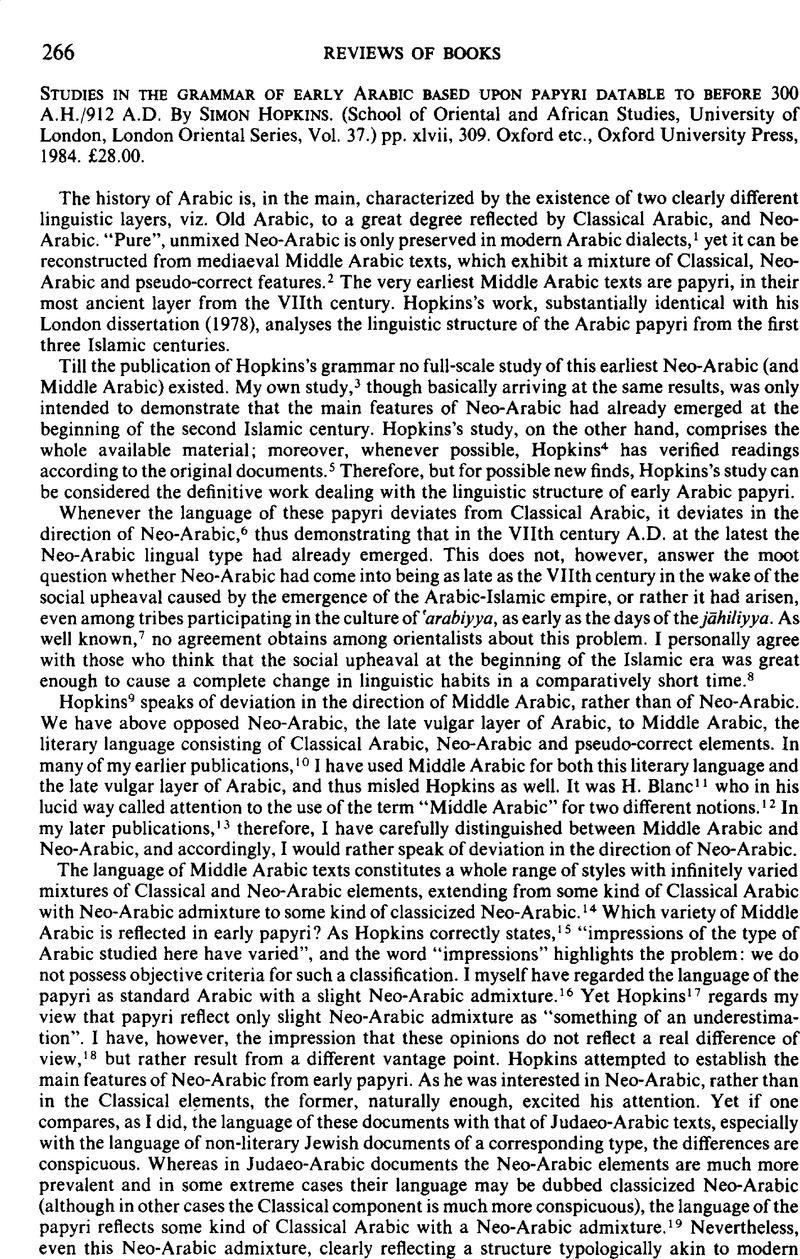No CrossRef data available.
Article contents
Studies in the grammar of early Arabic based upon papyri datable to before 300 A.H./912 A.D.. By Simon Hopkins. (School of Oriental and African Studies, University of London, London Oriental Series, Vol. 37.) pp. xlvii, 309Oxford etc., Oxford University Press, 1984. £28.00.
Published online by Cambridge University Press: 15 March 2011
Abstract

- Type
- Reviews of Books
- Information
- Copyright
- Copyright © The Royal Asiatic Society 1986
References
NOTES
1 Yet even most modern dialects, to a certain extent at least, reflect the influence of Classical Arabic. Nevertheless, in these cases the Neo-Arabic linguistic system remains intact, though externally influenced by Classical Arabic.
2 For this definition of Middle Arabic cf. below par. 4.
3 The Emergence and Linguistic Background of Judaeo-Arabic, a Study of the Origins of Middle Arabic, 1st edn, Oxford 1965, 2nd edn, Jerusalem 1981, pp. 123–32.Google Scholar
4 p. xlvi.
5 Whenever it was impossible to check the original document, Hopkins has expressly stated it, e.g. p. 47, n. 22; p. 108, n. 12; p. 243, par. 292; p. 258, n. 3.
6 p. xlvi.
7 V. e.g. Blau, J., “The Beginnings of the Arabic Diglossia. A study of the Origins of Neoarabic”, Afroasiatic Linguistics, vol. 4, issue 4, 1977, p. 16;Google ScholarFischer, W.—Jastrow, O., Handbuch der arabischen Dialekte, Porta Linguarum Orientalium N.S. xvi, Wiesbaden 1980, pp. 15–17.Google Scholar
8 Nevertheless, I disagree with Versteegh, K., who in his Pidginization and Creolization: The Case of Arabic, Amsterdam Studies in the Theory and History of Linguistic Science, Series iv, vol. 33, Amsterdam/Philadelphia 1984,CrossRefGoogle Scholar claimed that, in their first stage, the Arabic dialects were pidginized, to be later influenced by Classical Arabic. What militates against this view is that the “marginal” Arabic dialects (with which Versteegh deals extensively, e.g. pp. 6; 29 ff.; 94 f., but without inferring what seems to us the correct conclusions), which, being less exposed to the influence of Classical Arabic, should, were Versteegh's theory correct, reflect a much more pidginized structure. As a matter of fact, however, these isolated dialects are characterized by a rather complicated structure, which cannot be compared with the extremely simplified structure of really pidginized languages.
9 p. xlvi.
10 Yet, happily enough, not in all of them, v. e.g. “The Importance of Middle Arabic Dialects for the History of Arabic”, in Studies in Islamic History and Civilization, Scripta Hierosolymitana ix, Jerusalem 1961, p. 217.Google Scholar
11 Tarbiz 36.407 (1967; in Hebrew, : v. the English summary pp. v–vi).Google Scholar
12 Toll, C. (Acta Orientalia 37, 227–9, 1976,Google Scholar and Zeitschrift für arabische Linguistik 13.16–17; 18–19, 1984),Google Scholar on the other hand, was, in our opinion, wrong in totally discarding Middle Arabic (a time-honoured expression, already used by Fleischer, H. L. in 1854 in Verhandlungen der Königlich Sächsischen Gesellschaft der Wissenschaften, Philol.-histor. Classe, p. 4,Google Scholar repeated in his Kleinere Schriften iii, Leipzig 1888, p. 155).Google Scholar Toll had, it seems, the right feeling that Middle Arabic should not be used for both a period (midway between old and modern) and a style (midway between classical and vernacular), yet, contrary to Blanc's lucid insight, his view was somewhat blurred, and he did not assess the situation correctly. If Neo-Arabic is used to designate pure vernacular, both in the Middle Ages and modern times, and Middle Arabic for marking the language of texts consisting of Classical Arabic, Neo-Arabic and pseudo-correct elements, no justification exists for discarding the well-established notion of Middle Arabic.
13 V. e.g. Diglossia, p. 5, n. 30; Grundriss der Arabischen Philologie, Band I: Sprachwissenschaft, ed. Fischer, W., Wiesbaden 1982, p. 96;Google ScholarEmergence 1981, p. 215.Google Scholar
14 Cf. Emergence, p. 25.Google Scholar
15 p. xlvii.
16 Emergence, p. 132;Google ScholarDiglossia, , p. 17.Google Scholar
17 p. xlvii.
18 V., Emergence, 1981, pp. 239–40.Google Scholar
19 It is on purpose that I do not call this language post-Classical, since I would prefer to call post-Classical a language that differs from Classical Arabic in syntax and phraseology, yet is more or less identical with it in morphology.
20 V., A Grammar of Christian Arabic based mainly on South-Palestinian Texts from the First Millennium, Corpus Scriptorum Christianorum Orientalium, 267. 276, 279, Louvain 1966–1967, p. 304,Google Scholar par. 203.
21 I am prevented, for obvious reasons, from dealing with the arrangement of the material. Hopkins, to my deep satisfaction, has chosen to follow my Christian Arabic (p. xlv). Perhaps another review will contribute to Middle Arabic studies by critically discussing the arrangement of the material.
22 On the other hand, I would rather omit completely Classical occurrences, as the use of shattā with inanimate plurals (p. 145, n. 7) or the use of wa-iyyā (p. 123, par. 108, n. 1).




